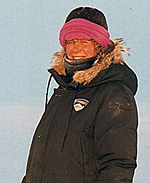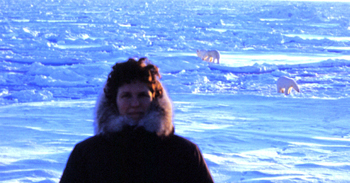
Editor’s note: This is one in a series of articles featuring UD polar scientists that will appear on UDaily during the International Polar Year. For a gateway to past and future articles, be sure to visit UD’s polar research web page at [www.udel.edu/research/polar].
3:49 p.m., July 13, 2007--Three scientists--two with close ties to the University of Delaware--lived in a frigid ice camp this spring as part of a $1.4 million National Science Foundation project they have dubbed SEDNA, for Sea-ice Experiment: Dynamic Nature of the Arctic.
SEDNA also is the name of an Inuit goddess of the Arctic, and the acronym was selected to reflect the International Polar Year focus on the stewardship of the polar regions and to recognize the strong representation of women in the project's leadership roles.
The SEDNA team included Cathleen Geiger, associate research professor in UD's Department of Geography with the Center for Climatic Research, and alumna Jacqueline Richter-Menge '79, '81M, a research civil engineer with the U.S. Army Corp of Engineers Cold Regions Research and Engineering Laboratory (CRREL). Working closely with them was Jennifer Hutchings of the International Arctic Research Center at the University of Alaska Fairbanks
“The Arctic sea ice cover, which is undergoing a lot of stress, plays an important role in the climate,” Richter-Menge said. “As temperatures rise, there is less sea ice, and the less sea ice, the higher the temperature because there is a reduction in the white ice surface that bounces the sun's rays back into space.”
Richter-Menge said the project studied the mass balance of the ice cover, taking into account the area covered and the thickness of the ice. “Due to winds and ocean, this is a very dynamic ice cover that moves around quite a lot,” she said. “We measured changes in volume and thickness as it drifts around the Arctic.”
Researchers also considered volume changes as the ice cracks and floes move apart, some creating new areas and others coming together and, at the point of intersection, forming ridges.
“We want to get a better understanding of the process,” Richter-Menge said. “This will enable us to create better models, which in turn will enable us to make more accurate predictions. We have seen improved weather forecasts and someday would like to improve climate forecasts.”
This was Richter-Menge's 20th trip onto the Arctic sea ice, Geiger's first ice camp, although she has been on 10 research cruises and five of those to the Arctic, and Hutchings' second ice camp.
As the scientists endured frigid temperatures of around -30 degrees Fahrenheit at the ice camp, other researchers were stationed at Prudhoe Bay and Fairbanks in Alaska to conduct satellite imaging and computer modeling that includes remote sensing work by scientists in UD's Video Image Modeling and Synthesis Laboratory.
The two-week field camp took advantage of a planned U.S. Navy ice camp. The season and location of the camp occur when and where this dynamic component dominates the mass balance of an ice cover that is nearing its maximum annual mean thickness.
Using helicopters, snowmobiles and human-powered sleds, researchers on the ground “deployed instrumentation on buoys and sent information to the mainland via satellite,” Richter-Menge said, adding, “And we will continue to get information until the instrument sinks or is eaten by a polar bear, which is not unheard of.”
Sea ice fieldwork is important because while remote sensing done via satellite is valuable in determining the extent of the ice, it has not yet been as precise in gauging the thickness of the ice. “We need information on the thickness, and also on how the thickness changes,” Richter-Menge said. “It is important to know if the sea ice cover is melting at the surface or below, whether the atmosphere is causing the melting or the ocean is causing the melting.”
By combining work on the ice with that at VIMS and the University of Alaska, she said the team hopes to develop a long-term way to monitor what is going on in the Arctic.
“The success of this project is an enormous amount of team effort,” Geiger said. “Everyone on the team has a critical role to play.”

Geiger made her first trip in 1984 as a junior in college. “It's one of the few places on Earth where you feel like you are standing on a planet,” she said. “From a helicopter or aircraft, you can actually see the Earth's curvature and get a sense of the Earth as a globe. It's as close to being in outer space as one can get and still be standing on Earth.”
Sea ice is “terribly barren,” Richter-Menge said, adding, “It puts oneself in perspective. Your are a small speck on the landscape.”
She said ice camps are very cold and said it is hard working in such conditions. Those conditions can grow even more treacherous if a break in the ice develops. “We are always on the lookout for cracks,” she said, “and sometimes we have had to abandon the camp.”
Richter-Menge said she was pleased to be part of the project from the outset, and even more so when she learned of involvement by scientists from her alma mater. “It is great to be able do this work with people from UD,” she said.
A number of educational outreach efforts were included at the ice camp, including Geiger's sponsorship of a Vermont high school teacher through the Arctic Research Consortium of the United States (ARCUS) PolarTREC program.
Collaborating with UD, the University of Alaska and CRREL in the venture were researchers from the Alfred Wegner Institute, Cambridge University, the University of Iceland, the University of Colorado and NASA.
Geiger is affiliated with the UD Center for Climatic Research, which was established in 1978. Since its inception, one of the main themes of research in the center has been hydroclimatology, or the role of water in climatology. That includes the cryosphere, or the frozen constituents of water, including glaciers, atmospheric ice, permafrost, snow and sea ice.
Geiger has been a member of the Center since her post-doctoral studies in 1998, serving as a research fellow and working with students in both the departments of Geography and Computer and Information Sciences. “There are only a few tens of scientists in the world who engage in this type of field-oriented sea ice research, and most of them are close to retirement,” she said. “It is extremely important to begin an active training program to teach the next generation the necessary sea ice field methods and the knowledge that has been collected primarily over the last 50 years by a single generation of scientists.”
The Center is working with the Department of Geography to expand its research capabilities, and Geiger joins its faculty as a research professor. She said the position provides “an incredible opportunity for students to directly participate in projects being jointly conducted by UD and CRREL, the only national lab in the country specializing in cold regions research and engineering.”
Geiger said that although she has worked hard to achieve her position and level of expertise, she “can see that the hardest work is still ahead of me as I work to transfer my knowledge, and that of my generation, to the next wave of young scientists.”
She predicted the next generation of field polar scientists “will see changes on this earth that my generation never even dreamed about when we were just starting out. We always assumed that the ice would always be there, as it has been for hundreds of thousands of years. This new generation will grow up under the new paradigm of sea ice--and its big brother, the glaciers--as a geophysical phenomenon on the endangered species list.”
Article by Neil Thomas

